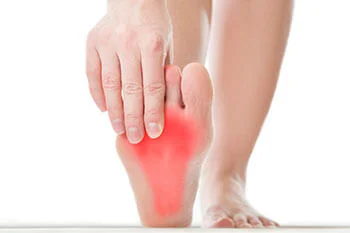Table of Contents
Introduction
Adult Acquired Flatfoot, also known at Posterior Tibial Tendon Dysfunction (PTTD), is a progressive disorder that involves a compromise of the tibialis posterior tendon and ligaments that support the inside arch. The condition most commonly affects women after the age of 40 and is characterized by a noticeable collapse or sagging of the arch with an outward shift of the forefoot/heel and inward shift of the ankle (see photo).
There are four clinical stages (see table below) of the disorder as the condition worsens, with each stage becoming progressively more disabling. The final stage involves separation of the ankle joint along with all the joints in the hindfoot. It is important to diagnose this problem early and begin treatment to slow the disease process. Surgery maybe needed to ultimately stabilize the arch.
How Can I Tell if I Have Adult Acquired Flatfoot?
A simple clinical test for adult acquired flatfoot is to:
1. Place your hands on a countertop for balance.
2. Stand on the foot with arch pain and lift your other foot off of the ground.
3. Try and stand on your “tip toes” with your painful foot.
If it is impossible to lift the heel, the arch structure maybe compromised. Individuals with adult acquired flatfoot can not lift their heel when performing a heel-lift on one foot. We would recommend a clinic appointment to evaluate the problem and create a treatment plan tailored to you and your lifestyle.
Simplified Stages of Posterior Tibial Tendon Dysfunction
Stage
Exam
Symptoms
Treatment
- Normal Anatomy
- Arch pain
- Conservative
- Arch support
- Physical therapy
2
- Mild decrease in arch
- Flexible
- Difficulty with heel raise test
- Arch pain
- Surgery
- Usually focused surgical procedures
3
- Moderate decrease in arch
- Rigid
- Unable to do heel raise
- Arch pain
- Pain in outside of foot
- Surgery
- Usually fusion of multiple foot joints
4
- Severe decrease in arch
- Rigid
- Unable to do heel raise
- Ankle changes
- Arch pain
- Pain in outside of foot
- Ankle pain
- Surgery
- Usually fusion of multiple foot joints
- Total ankle replacement


